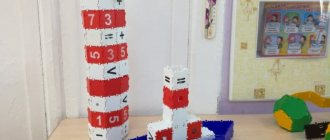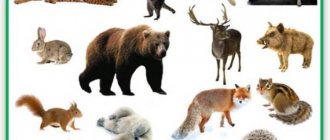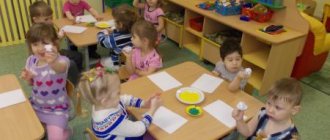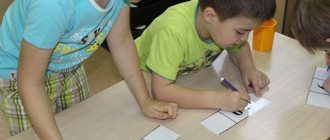Summary of the plot game “Cooking Lunch”. Lesson plan on the topic
Program content:
- Learn to name and consistently perform actions,
- clarify with the children the purpose of the dishes,
- develop initial role behavior skills,
- expand the vocabulary of “hot”, “sweet”, “serving”, “dishes” and activate their speech,
- to cultivate attentiveness, caring, a desire to take care of the doll, and a culture of behavior while eating.
Material : doll, kitchen and tableware - plates, forks, spoons, knives, cups, saucers, tablecloth, table, chairs.
Progress of the game:
Educator : Soon the doll Masha will return from a walk, she has been playing for a long time and is hungry, let's prepare her porridge and compote. But first we have to get dressed, because we are going to cook like real chefs. Aprons will prevent us from getting dirty, and scarves will prevent hair from getting into the food. (Children dress in aprons and scarves with the help of a teacher).
The teacher asks : -What dishes should I take?
Children : Pan, plate, knife, spoon, cup, board.
The teacher prepares the dishes (pot, knife, plate, cup) together with the children. Then he pours water from a bucket into a pan and puts it on the stove.
Educator : Children, what should you do with the fruit first?
Children : - Wash.
Educator : You need to wash the fruits correctly, otherwise harmful microbes will remain on them, and chop them finely. Dasha wash the fruits, and Aliya cut the fruits on the board.
Educator: What fruits did you cut?
Children : Apples, pear,
The teacher warns : - The water in the pan is already boiling, Nastya, put the fruit in the pan and stir with a spoon.
Educator : Now let’s add sugar, the compote will be tasty and sweet.
-Children, what kind of compote will it be?
Children: - delicious, sweet.
Educator : Let's taste the compote, cover the pan with a lid and let it continue to cook.
Oh, so many different things to do!
Now the compote is boiling,
And now for our doll,
We'll make some sweet porridge.
Educator : The compote is ready, put the pan aside and take out a box of cereal.
The teacher explains : - the cereal is called rice, rice porridge will be tasty, and the doll Masha will be happy.
Vosk : What kind of porridge will we cook?
Children : - Rice porridge.
The teacher pours the cereal into a plate, approaches the child and shows him the grains of rice.
Educator : - The water has already boiled, we need to wash the cereal. Alice, pour water into a small saucepan and wash the rice. Now pour the cereal into boiling water and cook the porridge.
The teacher, stirring the porridge with a spoon, says::
Yes, yes, yes - the porridge will be good.
Cook the porridge slowly.
Educator: While our porridge is being prepared, we need to set the table.
The children and the teacher set the table.
Educator : The porridge is ready, and Masha has come from a walk. Shall we feed Masha?
Children : Let's feed.
The teacher says : It’s unpleasant to eat with dirty hands, because worms can get into the tummy and Masha will get sick.
Children wash the hands of the doll Masha and sit him down at the table.
The teacher asks the children to wish the doll Masha a bon appetit. The children feed Masha, and the teacher says:
This-
Good girl
Her name is Masha!
And this is-
Her plate.
And in this plate...
No, not porridge,
No, not porridge,
And you guessed right!
Masha village,
Ate porridge-
All
How much they gave!
After lunch, the teacher invites one of the children to clear everything from the table
Project for senior preschool children “Miracles for the New Year”
Project “Miracles for the New Year”
Senior preschool age
Project passport
Project implementation period: December
Group project, short-term
Project participants: teachers, parents, music director.
Relevance:
New Year is the most beloved and long-awaited holiday for both adults and children. Children are looking forward to this holiday, waiting for Santa Claus to visit and dreaming about gifts.
However, as practice shows, children know little about the tradition of celebrating the New Year, what are the symbols of the New Year, what trees are decorated, what gifts are customary to give. In the process of reading works of art, we introduce children to the works of different authors and consolidate knowledge about the genres of works of art.
Target:
lay the foundations of a festive culture
Tasks:
— To introduce the traditions of celebrating the New Year, the customs of celebrating the New Year holiday, its paraphernalia, and characters.
-Unlock the capabilities and creativity of children through a variety of activities.
— Arouse an emotionally positive attitude towards the upcoming holiday;
-Promote the development of children's imagination, attention, memory and speech.
-Strengthen connections between preschool and family. Encourage parents to engage in joint creative activities with their children.
-Create a positive mood on the eve of the New Year holiday.
Project implementation stages
Preparatory stage
Goal: selection of necessary literature, material, creation of interest among project participants.
Main stage
Goal: organize children's activities around this topic; conduct conversations, classes, read fiction, organize creative activities, make New Year's crafts together with parents.
The final stage
Goal: exhibition of New Year's crafts by children and parents "Father Frost's Workshop", New Year's party.
Project work plan
Educational play activities
Cognitive development “Winter sorceress is coming”
Artistic and aesthetic development of “The Little Stars Are Dancing”
Speech development “Reading P. Bazhov’s fairy tale “The Silver Hoof”
Artistic and aesthetic development “Big and small spruce trees”
Artistic and aesthetic development “Fir branches”
Cognitive development "Unsafe winter fun"
Speech development “Conversation based on P. Bazhov’s fairy tale “Silver Hoof”
Artistic and aesthetic development “Ringing bells”
Types of children's activities
| Name | Target |
| Physical development Outdoor game "Frost - Red Nose" | Introduce children to the rules of the game and practice running in different directions. |
| Speech development Conversation “How to greet guests” | Tell children about the upcoming holiday, how they celebrate it, the traditions of celebrating the New Year, and improve dialogical speech. |






